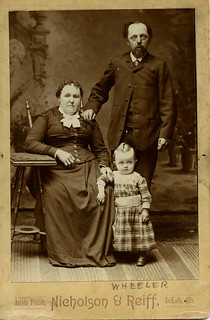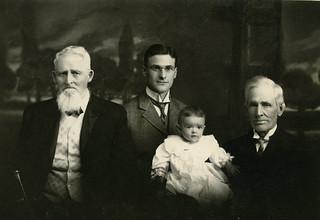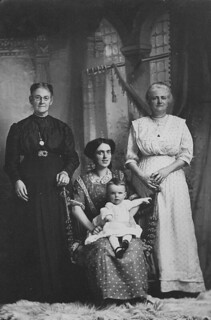Standards: CCSS.ELA-Literacy, RH.9-10.9
Compare and contrast treatments of the same topic in several
primary and secondary sources.
Objective: The students will be able to compare fashion trends in different
time periods by taking note of the materials and function of the
clothing worn by individuals in the Fay Portrait collection. The
students will observe the differences in fashion trends over time
and assess whether cultural or economic developments
influenced those changes. The students will prepare posters
which highlight their assessments with illustrated posters
presented before the class.
Evidence: H.W. Fay Portrait Collection R.C. 26
Time Frame: This lesson should take one to two days.
Essential Question: Do you make assumptions about people based upon their clothing?
Do you think that it is also possible to make assumptions about a society based upon its fashions?
Set Induction: Have the students look at side by side photographs of college students from the 1950s and
the 1960s. Have each students write one observation and pose one question about the
pictures on a piece of paper. Conduct a classroom discussion based upon the student’s
observations and inquiries. After this, introduce the essential question in front of the class:
Do you make assumptions about people based upon their clothing?
After the students have discussed this for a brief time, display the next question:
What assumptions have you made regarding the students in the photographs?
Have the students pair off and record one another’s answers to this question. Several sets of
partners may share their answers with the rest of the class depending upon the time
allowed.
Download Lesson Plan
Historical Background
Activity 1
Activity 2
Activity 3
Activity 4
1890-1900 Photographs
1900-1910 Photographs
1910-1920 Photographs
1920-1930 Photographs
Further Research
Teaching Ideas
Historical Background:
This lesson is based upon portraits collected between 1869 and 1945 by DeKalb newspaper publisher Herbert W. Fay. Fay’s collection consisted of over 50,000 photographs of some of the most notable people in the world. His collection consists of ninety different sittings of Lincoln and twenty five of Longfellow. These portraits represent a significant sampling of fashion in the 19th and 20th centuries.
Activity 1:
The students will break into four groups. Each group will be assigned a decade between 1890 and 1930. Using combined quick search tools and recollection, the students will create an impromptu timeline of American cultural and political events that occurred within their assigned decade. Each student will be given a bank of events to research. A bank of events is suggested below but the teacher can use their preferences and discretion to alter this list. The students will be required to give a date and a cited one sentence description of each event.
|
1890-1900:
|
|
|
|
Ellis Island opened. General Electric Company is formed. The Chicago World’s Fair or the Columbia Exposition takes place in Chicago. The first US patent for an automobile is issued. The Spanish American War. According to the official census, the US population increased by 21% in the decade.
|
|
1900-1910:
|
|
|
|
President William McKinley is assassinated. First public movie theater opens in Los Angeles California. Wilbur and Orville Wright take flight. The first transcontinental automobile trip occurs. The Pure Food and Drug Act and the Meat Inspection Act is passed. The US “Great White Fleet” of 16 battleships tours the world. According to the official census, the US population increased by 21% in the decade.
|
|
1910-1920:
|
|
|
|
The Panama Canal is completed. The first transcontinental airplane flight occurs.Ford Motor Company invents the first moving assembly line. First telephone conversation takes place between New York and San Francisco. The US joins the Allies in WWI.According to the official census, the US population increased by 15.4% in the decade.
|
|
1920-1930:
|
|
|
|
Women are given the right to voteLegal immigration quotas are established. The Indian Citizenship Act is passed. The NBC Radio network is formed. The first transatlantic fight occurs. The Great Depression begins. According to the official census, the US population increased by 16.2% in the decade.
|
After the student groups have completed their timelines, they will share their results with the rest of the class. This activity will provide an historical context for the students as they examine fashion changes that occurred between 1890 and 1930.
Activity 2:
The students will remain in their decade groups. They will each receive photographs of people from DeKalb County that feature fashion choices featured in their respective decades. The students will examine their decade’s photographs and each student will choose one to focus upon for closer inspection. Using the list of prompts below, each student will be required to compose three questions about their chosen image. The students will attempt to answer their own questions based upon their photo’s visual clues. After composing their questions and their answers, the students will exchange their image and their list of questions with a partner and attempt to answer their questions. After this the students will have a dialogue with their partner’s about their respective answers. The table will assist the students.
1890-1900 1900-1910 1910-1920 1920-1930




| Observe | Question | Reflect |
| The students will receive a bank of photographs from their group’s decade. The students will look at the whole picture as well as honing in on parts of the image possibly through the use of cropping tools. |
The students will pose three questions about one of their photographs. Personality: Economic Status: Activity: Occupation: Religious affiliation: Self-image: Mood: Weather: Person’s role in their family: Ambitions: Popular culture: Time period: |
Use visual clues from your photographs to provide evidence for the answers to three questions you have posed about your group’s photographs. |
Activity 3:
The students will summarize their reformulated ideas based upon their own and their partner’s questions and answers in a short paragraph and present their findings, along with the visual evidence contained in their photograph to the other groups.
Activity 4:
Each group will prepare a poster which advertises a clothing line for their decade. The advertisement will have a visual and a textual element which is descriptive of a historical change as seen in clothing during their decade. Below is an example:
 |
On the back of their poster the groups will compose a description of the historical context of their advertisement. Below is an example:
|
Finally the students will create group visual and textual timelines with their advertising posters that will show bring the various decade groups ideas into a broader historical context.
Here are some interesting and effective advertisements that a teacher can look at in order to find examples for the class to spark ideas.
http://www.hongkiat.com/blog/70-creative-advertisements-that-makes-you-look-twice/
Background on teaching history through fashion:
History through Fashion by Iole Apicella
http://www.yale.edu/ynhti/curriculum/units/1991/2/91.02.01.x.html
Teaching using photographs as primary sources:
Library of Congress Teaching tips:
Analyzing Primary Sources: Photographs and Prints, Professional Development:
http://www.loc.gov/teachers/professionaldevelopment/selfdirected/photographsandprints.html
Edutopia
Online Photography Archives Enable Teaching with Primary Sources
http://www.edutopia.org/life-magazine-online-photography-analysis
Teaching History Clearing House
Crop It: Students use paper cropping tools to learn about visual images
http://teachinghistory.org/teaching-materials/teaching-guides/25697
Questions for Crop it.